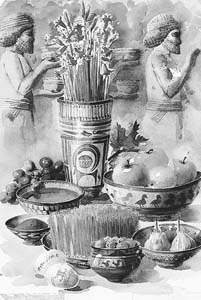Oriental Institute to sponsor Persian New Year celebration March 28
William HarmsNews Office
The Oriental Institute will celebrate the Persian New Year, Naw Rouz, with an Iranian movie premiere and other events beginning at 6 p.m., Wednesday, March 28, at the Oriental Institute.
 Seven traditional objects are set on a holiday table for Naw Rouz, including sprouted wheat, apples, pudding, dried fruits, garlic, wild rue and vinegar. |
The celebration will begin with visits to the Persian Gallery, which contains the nation’s premier archaeological collections of artifacts from civilizations that once flourished in what is now Iran. Among its treasures are statues, coins and other material from Persepolis, the capital of the Persian Empire.
Members of the local Iranian community as well as University scholars are arranging activities that will explore the cultural heritage of modern Iran. John Woods, Professor in History and Director of the University’s Center for Middle Eastern Studies, which is helping coordinate the event, will present a talk about Naw Rouz at 7 p.m. in Breasted Hall, followed by the premiere of the film Children of the Sun at 7:30 p.m. In addition, Heshmat Moayyad, Professor in Near Eastern Languages & Civilizations, will give a poetry reading.
Children of the Sun was shot in villages throughout Iran that were in the path of the August 6, 1999, total eclipse of the sun. The documentary looks at the ancient cultural heritage of the area and includes interviews with a number of scholars from the University, said Mansooreh Saboori, a filmmaker of Iranian heritage living in Chicago, who shot and edited the film.
Naw Rouz, which means new day, incorporates many customs from pre-Islamic times and is celebrated among the Kurds, Iranians and other people throughout central Asia.
“It is seen as a time of renewal and rejuvenation,” said Woods. “People put on new clothes, they clean their houses two weeks before the event and observe other customs, such as ‘13th day out of doors,’ in which they are out of their homes the 13th day after the new year so that spirits can come into their homes and purify them.”
The holiday has been adapted to recognize Islam by including the Koran as one of the traditional objects gathered to celebrate the occasion. The solar new year of 1380 relates to the lunar Islamic calendar. In addition to the Koran, or Jewish or Christian holy books for members of those faiths, seven traditional objects, all of which begin with the letter “S” in the Iranian alphabet, are set on a holiday table. Sprouted wheat, apples, pudding, dried fruits, garlic, wild rue and vinegar are among possible items on the table, called a Haft Seen (seven S’s) table.
Other items on the table may include those associated with spring celebrations elsewhere, such as a bouquet of narcissus and colored eggs. A table set for Naw Rouz also may include coins, rice, fruits, bread and goldfish.
Some of the items relate to old beliefs, such as an orange leaf floated in a bowl of water. If the orange leaf moves, people believe it is because the earth moved, which is supposed to happen on the first day of the new year, the day of the vernal equinox, around March 20 or the first day of spring.
![[Chronicle]](/images/small-header.gif)